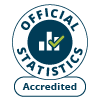Persistent poverty: 2023
For the period ending 2023, data on people in persistent poverty, defined as being in relative income poverty in at least 3 out of 4 consecutive years.
This file may not be fully accessible.
In this page
Introduction
Data on persistent poverty in Wales comes from Department for Work and Pensions (DWP) and is based on the Understanding Society longitudinal survey dataset. In their Income Dynamics report (DWP) DWP define a person to be in persistent poverty if he or she is in relative income poverty in at least 3 out of 4 consecutive years.
The figures below are subject to future revisions to improve data quality. New information can be collected from respondents which affects their data in earlier years. For this reason users should refer to the latest DWP Income Dynamics report for data on previous periods.
Main points
- An individual in Wales had a 12% chance of being in persistent poverty between 2019 and 2023 (after housing costs were paid).
- The likelihood of being in persistent poverty varies by region/country. In England, the figure was 12%, in Scotland 14%, and in Northern Ireland 10% (after housing costs were paid).
- A child in Wales had a 16% likelihood of being in persistent poverty between 2019 and 2023 (after housing costs were paid).
- This was lower than the likelihood for England (18%), Scotland (23%) but higher than in Northern Ireland (14%).
- A working age adult in Wales had a 11% likelihood of being in persistent poverty between 2019 and 2023 (after housing costs were paid).
- This was the same as that for England and Scotland. The figure for Northern Ireland was lower at 10%.
- A pensioner living in Wales between 2019 and 2023 had an 12% likelihood of being in persistent poverty (after housing costs were paid).
- This was higher than the likelihood in England and Scotland (both at 11%) and Northern Ireland (6%).

